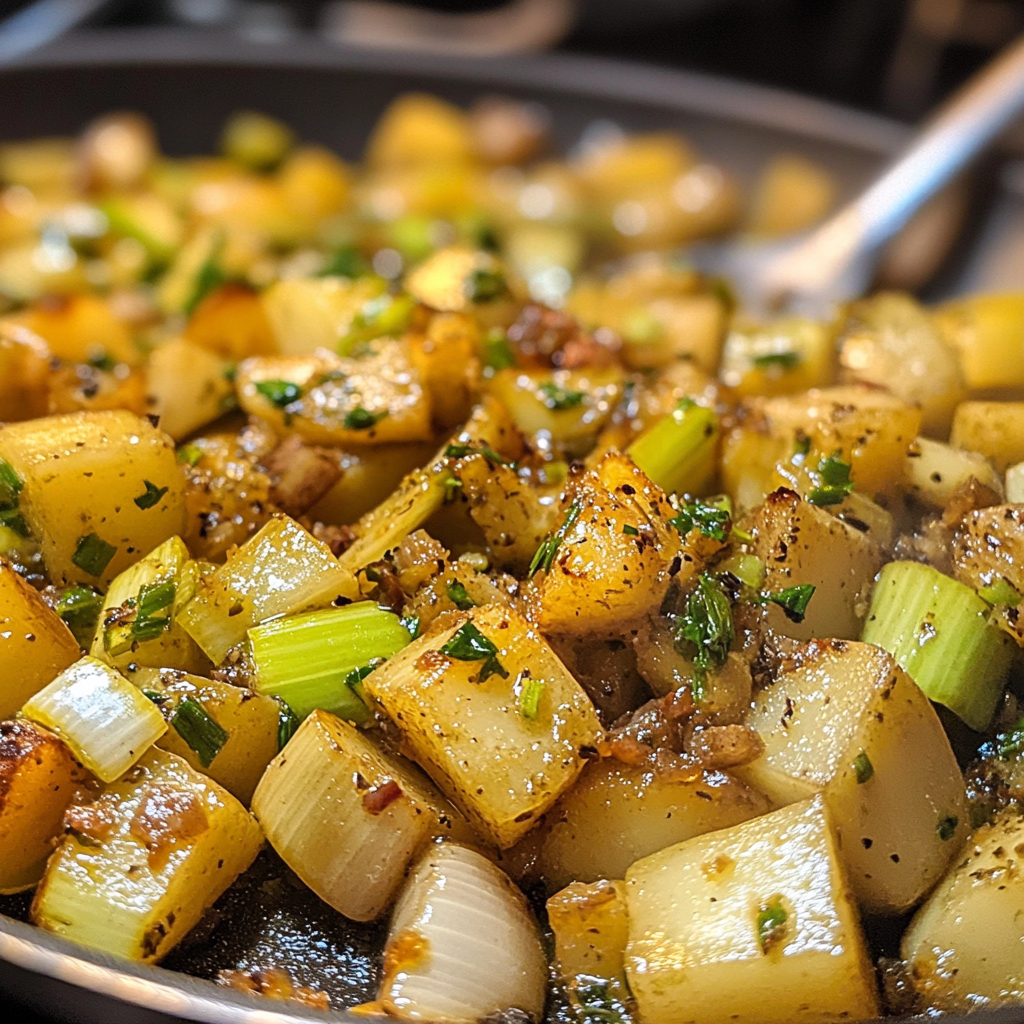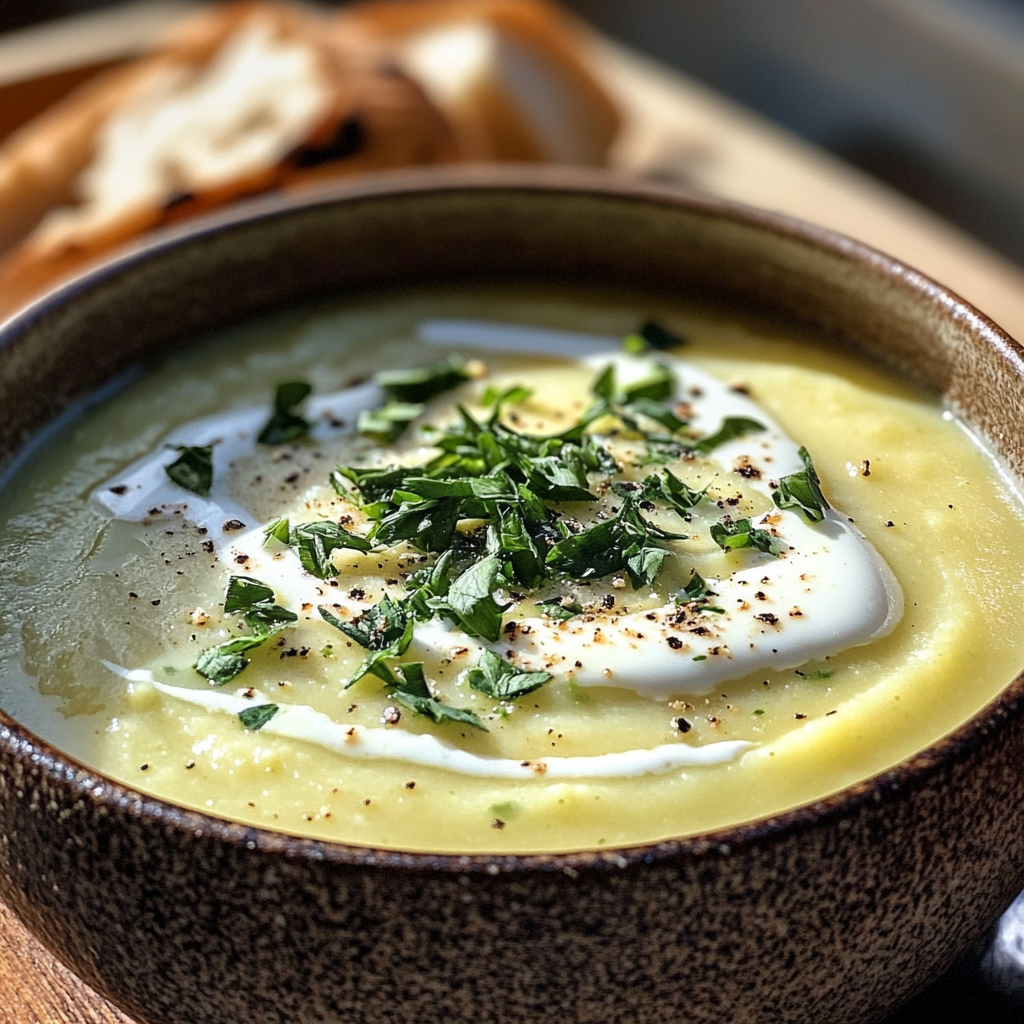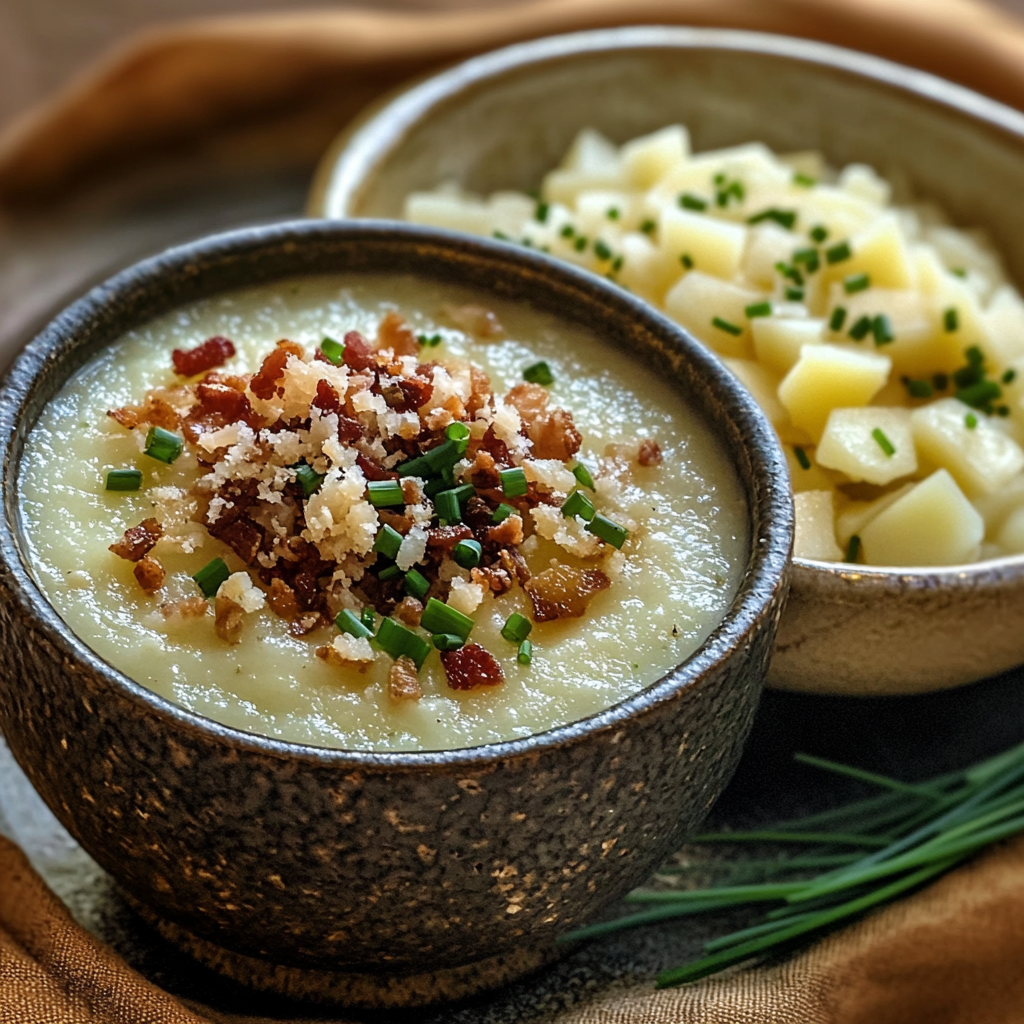Introduction
Leek and potato soup is a beloved comfort food, perfect for cozy nights and chilly afternoons. But there’s nothing more disappointing than putting in all the effort only to wonder, “Why does my leek and potato soup taste bland?”
This common problem happens to many home cooks and can stem from a variety of reasons, ranging from seasoning mistakes to improper cooking techniques. Thankfully, a bland leek and potato soup is an easy problem to fix once you understand the cause. In this article, we’ll dive deep into the reasons your soup might lack flavor and offer practical solutions for turning your bland soup into a dish bursting with taste.
Common Causes of a Bland Leek and Potato Soup

1. Lack of Proper Seasoning
Seasoning is the cornerstone of any dish, and if your leek and potato soup tastes bland, the most likely culprit is a lack of proper seasoning. Potatoes, especially, are notorious for soaking up salt, making it easy for your soup to end up under-seasoned.
How to Fix It:
When making leek and potato soup, it’s crucial to season in stages. Start with the base of your soup, adding salt and pepper to the sautéed leeks. As you add the potatoes and broth, season again to ensure that the flavor is layered throughout the cooking process. Taste the soup as it simmers, adjusting the seasoning as necessary. Potatoes absorb a lot of salt, so don’t be afraid to add more than you might in other dishes. However, always taste as you go to avoid over-salting.
Beyond salt and pepper, you can add herbs like thyme, parsley, or rosemary. These herbs not only add complexity to the flavor but also complement the mild sweetness of the leeks and the earthy potatoes. You can also try adding a dash of smoked paprika or cumin for a subtle spice that will enrich the overall flavor profile.
Internal Link Opportunity: For more detailed information on seasoning, check out our perfect mashed potatoes with gravy recipe, where we explore how to balance seasoning in potato-based dishes.
2. Not Enough Aromatics
Leeks have a mild flavor, and when they’re the star ingredient, the soup can easily fall flat if not supported by additional aromatics. If you’re asking yourself, “Why does my leek and potato soup taste bland?”, it might be because you didn’t use enough aromatics to build the base of the soup.
How to Fix It:
Aromatics like onions, garlic, and shallots are crucial to building depth and complexity in your leek and potato soup. When sautéing the leeks, start by cooking them with diced onions and minced garlic to form a fragrant base. This combination will infuse the broth with a robust flavor that enhances the natural sweetness of the leeks.
Garlic adds a savory punch, while onions provide richness and sweetness. If you’re feeling adventurous, you can also add celery and carrots for additional flavor. These vegetables build a strong base that will make your soup taste more complete and well-rounded.
To elevate the dish further, consider adding a bouquet garni (a bundle of fresh herbs) or tossing in some dried bay leaves while your soup simmers. These herbs gradually release their flavors, resulting in a more flavorful soup.
Internal Link Opportunity: For a more in-depth guide on incorporating aromatics, read our article on how to use sautéed vegetables to build better flavor in any dish.
3. Overcooking the Vegetables
Vegetables, especially leeks and potatoes, can lose their natural flavor when overcooked, leading to a soup that’s starchy and dull. If you’ve been wondering, “Why does my leek and potato soup taste bland?”, overcooking could be the reason. Overcooked vegetables release too much starch into the broth, resulting in a thick, pasty soup that lacks flavor and depth.
How to Fix It:
To prevent this, cook your vegetables gently and monitor them closely as they simmer. Potatoes should be cooked until they are tender but still hold their shape—use a fork to test their texture. Leeks should be soft but not mushy. If they break down too much, they lose their delicate flavor, leaving your soup tasting one-dimensional.
To avoid this issue, keep your soup at a gentle simmer rather than a rolling boil. A slower cooking process helps preserve the integrity of the vegetables and allows the flavors to meld together more effectively. If you do end up overcooking the vegetables, don’t panic. You can blend part of the soup to create a creamy consistency and leave some chunks for texture, giving the soup a more satisfying mouthfeel.
4. Weak Stock
One of the main reasons you might find yourself asking, “Why does my leek and potato soup taste bland?”, is that the stock you used isn’t rich enough. Stock is the backbone of any soup, and if it lacks flavor, your soup will too.
How to Fix It:
Whenever possible, use a homemade stock for your soup. Homemade stocks have a depth of flavor that store-bought versions simply can’t replicate. If you’re using store-bought stock, look for a high-quality, low-sodium option so that you can control the salt content yourself. To boost a store-bought stock, you can simmer it with vegetables like onion, garlic, and carrots, along with some herbs, for about 20 minutes before using it in your soup.
You can also add umami-rich ingredients like a splash of soy sauce, a spoonful of miso paste, or a Parmesan rind to the broth while it simmers. These ingredients impart a savory depth that enhances the overall flavor of the soup.
Internal Link Opportunity: For more tips on making flavorful stocks, check out our recipe on creating the perfect chuck roast with a rich homemade broth.
5. Lack of Acidity
When soup tastes flat or bland, it often needs a balancing element like acidity. A rich, creamy soup like leek and potato can easily feel heavy, especially if it’s missing a bright note to cut through the richness. If you’re still asking, “Why does my leek and potato soup taste bland?”, the answer might be a lack of acidity.
How to Fix It:
A small amount of lemon juice or vinegar added towards the end of cooking can transform your soup. Acidity helps balance the flavors, cutting through the richness of the potatoes and cream, and brings out the brightness of the leeks. Start with just a teaspoon of lemon juice or vinegar and taste before adding more. The goal is to enhance the flavor without overpowering the dish.
You can also add a small amount of white wine or mustard for a subtler, more nuanced acidity. A tablespoon of Dijon mustard stirred into the soup at the end of cooking adds both sharpness and depth, elevating the entire dish.
How to Fix Bland Leek and Potato Soup
1. Adjust Seasoning Gradually
If your leek and potato soup tastes bland, the first thing you should do is adjust the seasoning. Adding all your salt at once can lead to over-seasoning, so it’s essential to add small amounts of salt and pepper throughout the cooking process, tasting frequently.
How to Fix It:
If your soup tastes under-seasoned, try adding a small pinch of salt and freshly ground black pepper, then taste again. If the soup still feels flat, consider adding a sprinkle of garlic powder or onion powder. These seasonings can deepen the flavor without overshadowing the delicate taste of the leeks and potatoes.
As a finishing touch, add some fresh herbs like parsley, thyme, or chives just before serving. These herbs not only add a pop of color but also freshen up the soup’s flavor profile.
Internal Link Opportunity: Discover more about adjusting seasoning and saving a dish in our article on beef and leek soup recipes.
2. Add Fresh Herbs and Aromatics
Fresh herbs can make all the difference when fixing a bland leek and potato soup. Herbs like thyme, parsley, and chives bring brightness and contrast to the richness of the soup, while spices like cumin or smoked paprika can add warmth and depth.
How to Fix It:
Add herbs towards the end of cooking to preserve their freshness and aroma. Chives, for example, complement the mild onion-like flavor of leeks and add a lovely visual garnish. You can also chop parsley or thyme finely and stir them into the soup just before serving to ensure their flavors remain bright and vibrant.
Spices can be added earlier in the cooking process so they have time to bloom and integrate with the other ingredients. A small pinch of nutmeg or smoked paprika can bring warmth and complexity to your soup, transforming it from bland to flavorful.
3. Incorporate Dairy for Richness

Leek and potato soup should have a creamy, comforting texture. If your soup feels too thin or watery, it can taste bland, even if it’s properly seasoned.
How to Fix It:
Adding a dairy element like heavy cream, crème fraîche, or cream cheese can make your soup richer and more indulgent. Stir in the dairy towards the end of cooking to avoid curdling. For a healthier option, use Greek yogurt or coconut cream as substitutes.
If you’re avoiding dairy altogether, consider blending part of the soup to create a thicker, creamier texture without the addition of cream. This technique allows you to keep the soup light while still giving it a satisfying mouthfeel.
Enhancing Flavor with Additional Ingredients
Sometimes, even after making adjustments, you may still wonder, “Why does my leek and potato soup taste bland?” If that’s the case, you can take your soup to the next level by adding some additional ingredients for extra flavor and texture.
1. Roasting Vegetables
Roasting leeks and potatoes before adding them to your soup can significantly enhance the depth of flavor. Roasting caramelizes the natural sugars in the vegetables, bringing out their sweetness and adding a rich, smoky flavor to the soup.
How to Fix It:
Simply toss the vegetables in olive oil, sprinkle with salt and pepper, and roast in the oven at 400°F (200°C) until golden brown. Once roasted, add the vegetables to your broth and blend for a deliciously rich and flavorful soup.
Internal Link Opportunity: For more tips on roasting vegetables, check out our guide on creating a delicious roasted beef chuck.
2. Add Smoky Flavors
Adding a smoky element can completely transform a bland leek and potato soup. Ingredients like smoked bacon, smoked paprika, or even a dash of liquid smoke can give your soup a depth of flavor that’s hard to resist.
How to Fix It:
Try sautéing smoked bacon and using the fat to cook your leeks. Alternatively, stir in smoked paprika for a vegetarian option that still delivers that deep, rich, smoky flavor.
3. Nutty and Cheesy Toppings

If you’re still wondering, “Why does my leek and potato soup taste bland?”, try adding some toppings for extra flavor and texture. Grated Parmesan, sharp cheddar, or toasted pine nuts can add a savory, nutty flavor and make the soup feel more complete.
How to Fix It:
Top each serving of soup with a sprinkle of cheese or a handful of toasted nuts just before serving. If you want a vegan alternative, nutritional yeast is a great option that adds a cheesy, umami flavor without any dairy.
Conclusion
If you’re asking yourself, “Why does my leek and potato soup taste bland?”, now you have the tools and knowledge to fix it. Whether it’s due to under-seasoning, overcooking the vegetables, or using a weak stock, there are simple ways to enhance the flavor and create a rich, satisfying soup.
By adjusting your seasoning, using high-quality stock, incorporating fresh herbs, and adding a splash of acidity, you can easily elevate your leek and potato soup from bland to bold. Don’t hesitate to experiment with additional ingredients like roasted vegetables, smoky flavors, or cheesy toppings to make the soup even more delicious.
With these tips and tricks, you’ll never have to worry about bland leek and potato soup again. Happy cooking!

